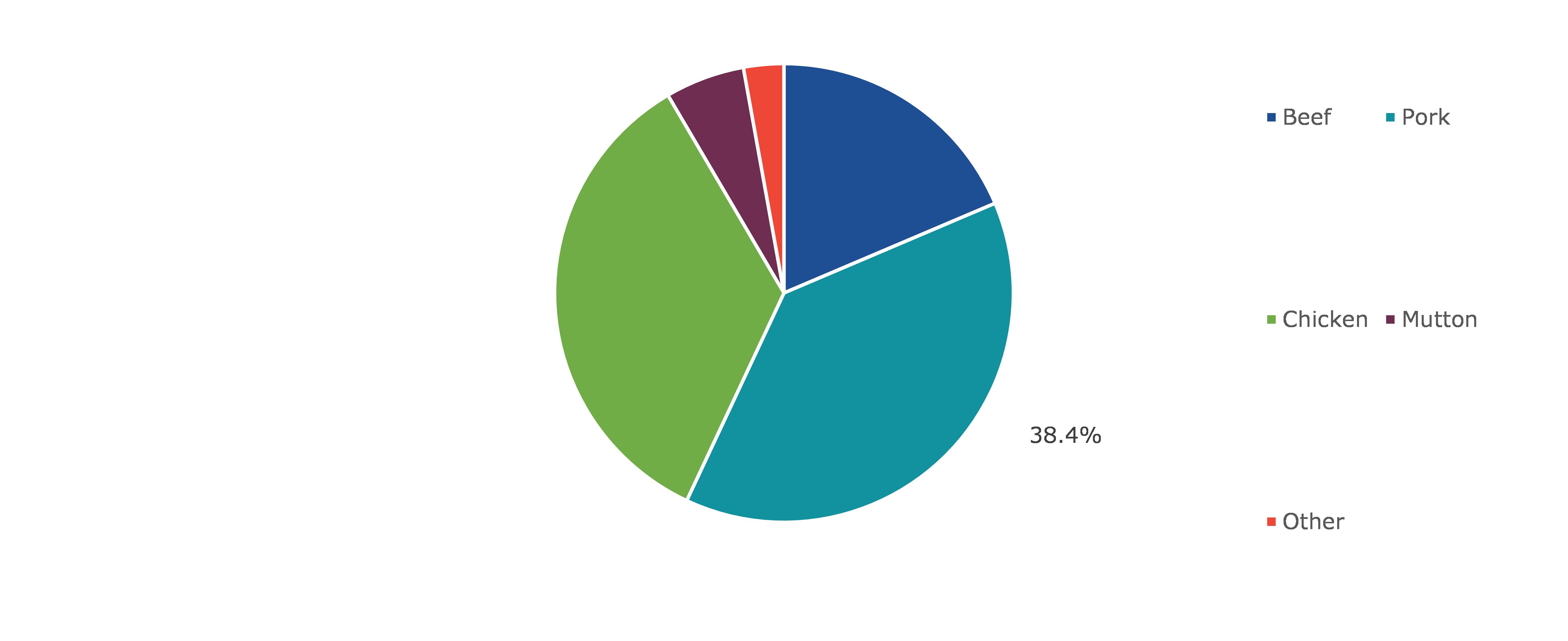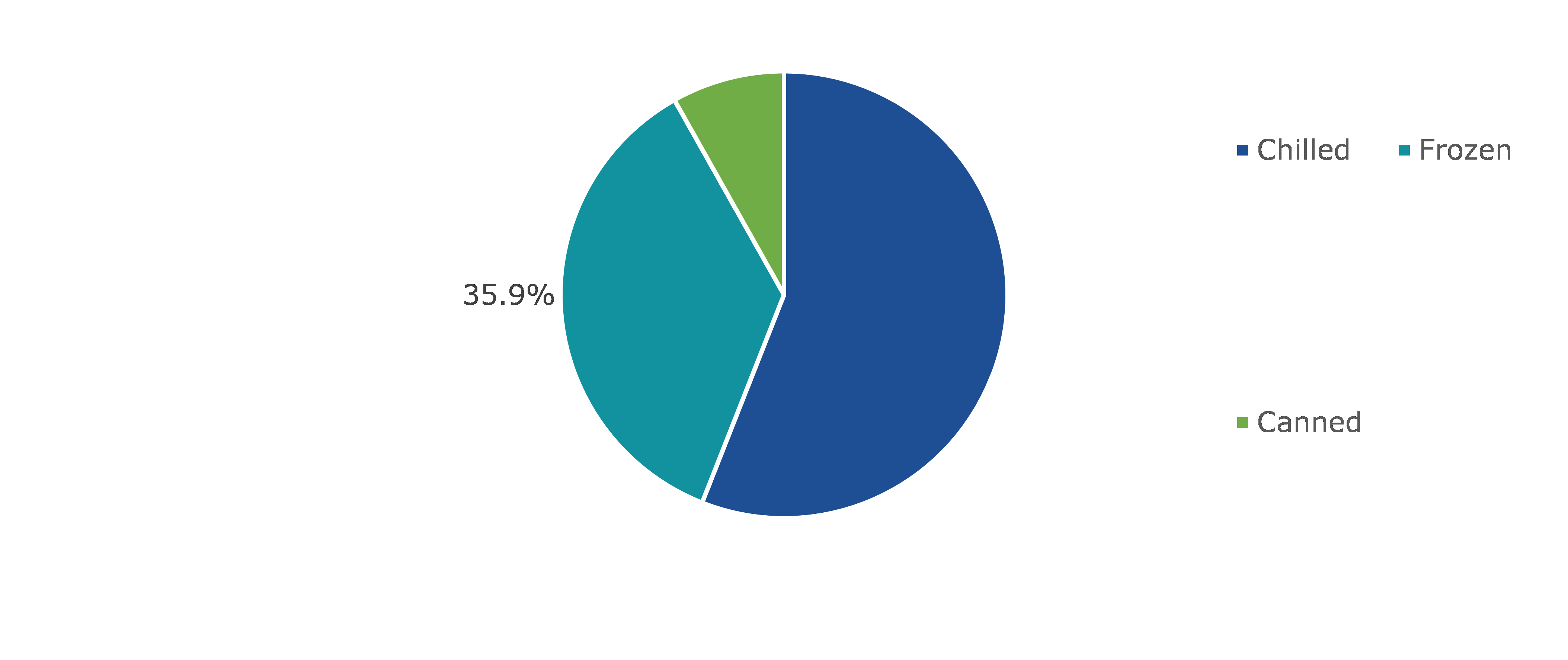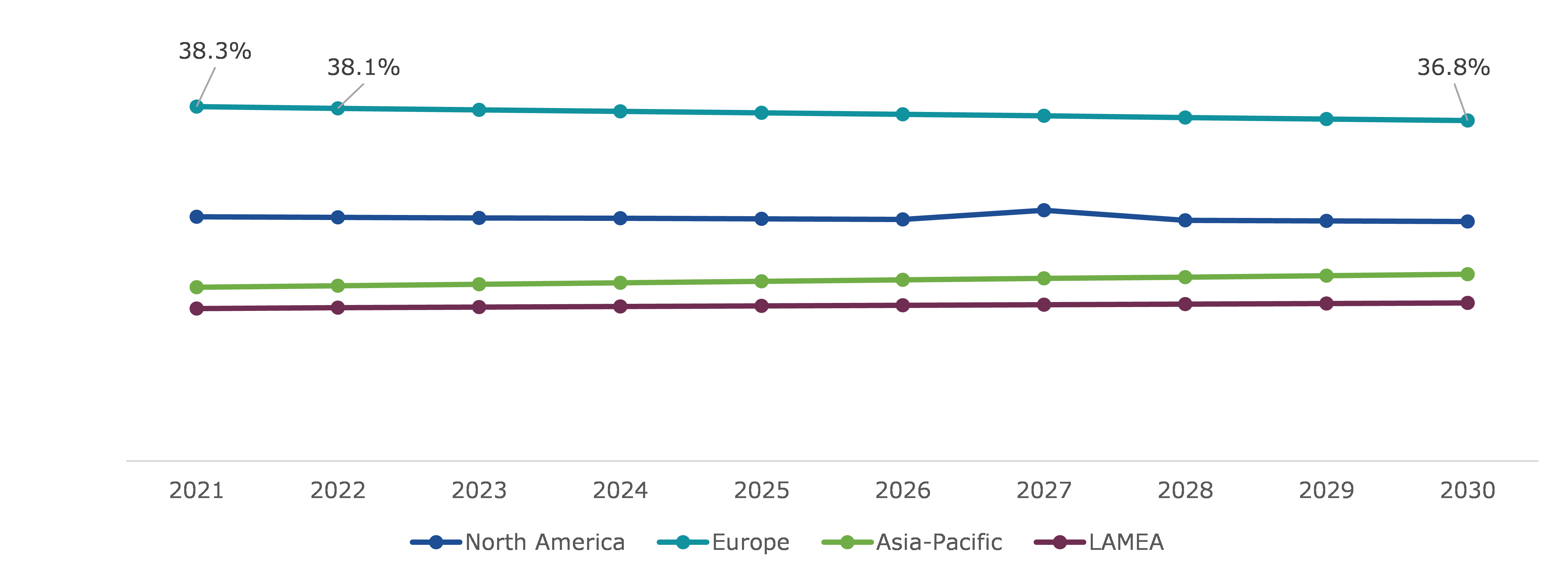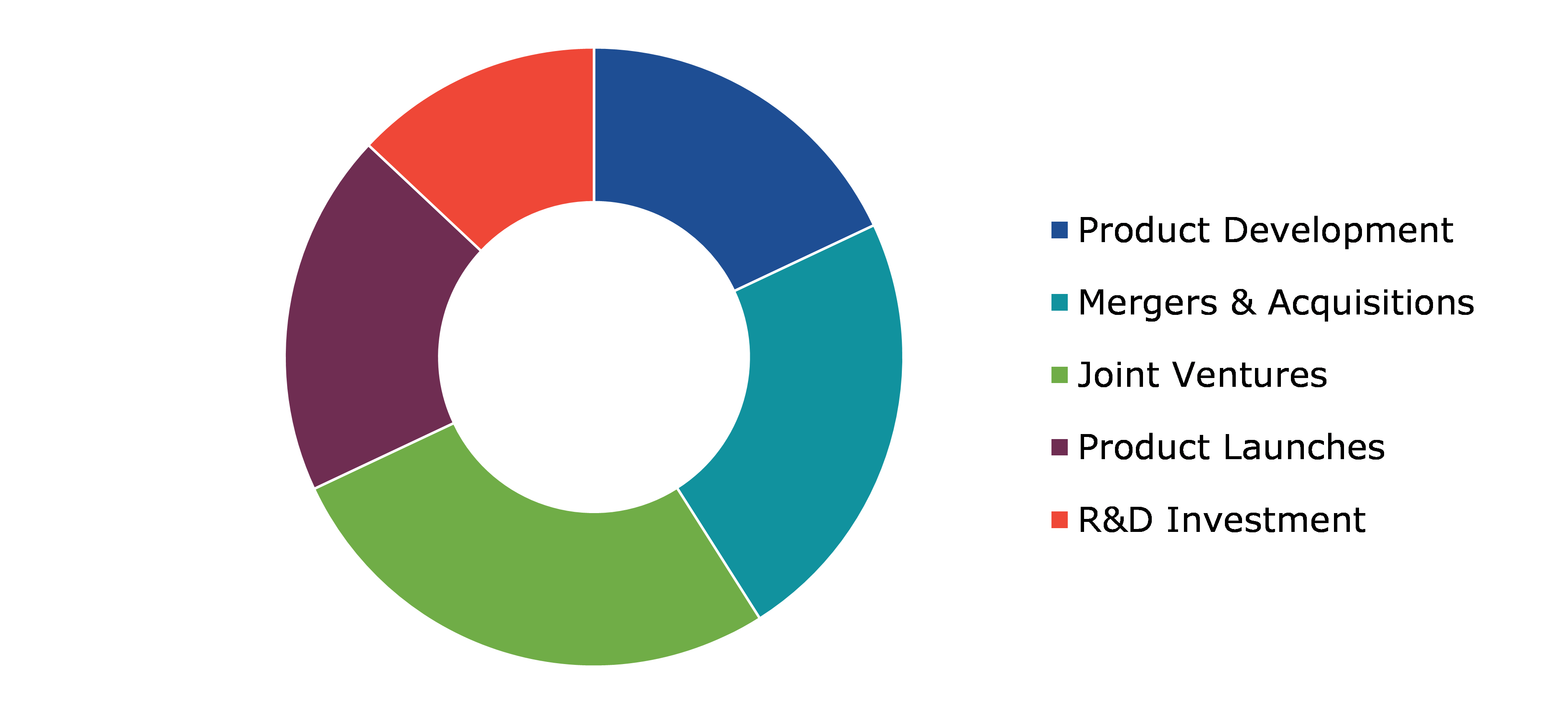Meat Products Market Report
RA08583
Meat Products Market by Processed Meat Type (Hamburgers, Sausages, Kebabs, and Nuggets), Meat Type (Beef, Pork, Chicken, Mutton, and Other), Packaging (Chilled, Frozen, and Canned), and Regional Analysis (North America, Europe, Asia-Pacific, and LAMEA): Global Opportunity Analysis and Industry Forecast, 2022–2030
Global Meat Products Market Analysis
The global meat products market is predicted to garner a revenue of $387.6 billion in the 2022–2030 timeframe, growing from $274.7 billion in 2021, at a healthy CAGR of 3.95%.
Market Synopsis
Meat products market is gaining huge popularity owing to increasing demand for processed meat globally. When meat is preserved by smoking, salting, fermenting, or adding any chemical to lengthen its shelf life and improve its taste, it is considered processed. Moreover, significant expansion of the global meat products market is mostly due to the rising popularity of flavored and nutritious meat products such as sausages, hot dogs, burgers, and other similar items. Furthermore, increased consumer purchasing power and the adoption of busy lifestyles are some of the factors driving the growth of the meat products industry. Furthermore, because people nowadays do not have a lot of time to prepare food, they have begun to adopt ready-to-eat or cook food products that take very little time to make and provide high-quality, tasty food. These kinds of things are propelling the market forward. Moreover, industry participants are forming strategic alliances and joint ventures to expand their geographic footprint and product portfolio.
However, notable growth in the number of vegans globally may obstruct the growth of the global meat products market. Moreover, post pandemic hatred towards certain animal meat with fear of having other contagious diseases is another aspect affecting the meat market and it may also create a negative impact on the meat products market, during the forecast period.
According to regional analysis, the Asia-Pacific meat products market accounted for $51.6 billion in 2021 and is predicted to grow with a CAGR of 4.78%, in the projected timeframe owing to rising meat products demand across the region. Moreover, growing demand for ready to eat meat products will drive the global market.
Meat Products Overview
Foods created from animals that have been treated in some way, such as roasting, seasoning, smoking, or adding sauces & seasonings are referred to as meat products. Processing has the primary purpose of reducing perishability and increasing the shelf life of the finished product. Meat products are susceptible to chemical reactions that cause deterioration, color, flavor, and smell changes, all of which decrease the product's quality. Nano/microcapsules containing natural antioxidants, probiotics, plant extracts with antioxidant & antibacterial activity, polyunsaturated fatty acid-rich vegetable oils, and essential oils can be used in meat products as alternatives to reduce these drawbacks. Moreover, meat items consumed around the world and can be a highly attractive beneficial food carrier due to the aim to develop superior formulations such as reduced fat and higher fiber in processed meats.
Moreover, according to an article by The World Counts, meat output has quadrupled from the mid-1960s and has doubled in the previous 30 years, from 1988 to 2018. Production is expected to rise in the future. By 2050, global meat consumption is estimated to reach 460 billion to 570 billion tons. Meat consumption would be 570 billion tons, more than double what it was in 2008. All such data showcase that the demand for meat products is growing rapidly.
COVID-19 Impact on Meat Products Market
The global crisis caused by COVID-19 pandemic has negatively affected most of the industries across various countries. The COVID-19 outbreak wreaked meat supply and production. The processed meat industry's distribution chain is primarily reliant on hotels, cafes, and restaurants. During COVID-19, fast food restaurants such as Subway, McDonalds, KFC, and Burger King were forced to close temporarily or permanently. Customers of these restaurant chains had a limited number of options for dining in. Due to travel restrictions, both cafes and hotels were closed. Due to the non-operation of this crucial distribution channel during the lockdown, the global meat products market suffered revenue losses. In addition, COVID-19 had a significant impact on meat production, distribution, and pricing, resulting in a global financial disaster. As a result of lesser output and increased demand due to panic buying, prices for meat and meat products began to climb. Meat output and demand were substantially reduced later due to supply restrictions and lower consumer purchasing power, resulting in a drop in meat prices. Because of the rapid spread of the COVID-19 virus among workers, meat packing plants began closing in early April 2020.
Furthermore, major meat industries companies such as Tyson Foods Inc., Smithfield Farms, JBS USA, and Cargill Inc. shut down or curtailed their meat processing plants. All of these factors are going to wreak havoc on the processed meat industry.
The market may have been impacted by the epidemic, but the reinstatement of all eating facilities following the pandemic may increase the market's long-term survival in the coming years. During the COVID-19 chaos, noticeable meat producers operating inside the market, such like Charoen Pokphand Foods PCL., are offering incorporated goods such as frozen foods and eco-friendly packaging. Furthermore, people all over the world prefer to ready-to-eat or frozen foods with a long shelf life. Given these considerations, the meat products market may present significant market opportunities in the coming years.
Increase in Demand for Ready-to-eat Meat Products to Drive the Market Growth
Increasing demand for ready-to-eat meat products with high nutritional value, such as high protein content and low cholesterol & calorific values, without sacrificing the product's flavor and taste profile is expected to drive the market growth. This is projected to spark a wave of ready-to-eat meat innovation in the coming years, boosting industry growth. Moreover, the ease of ready to eat meat in terms of time savings and low work required for meal preparation is propelling the industry forward. Additionally, the fact that these meals only need to be heated before being consumed has attracted the interest of the working population and millennial. On the other hand, the number of fast-food joints and restaurants throughout the world grows, so does the demand for freezer meat for their daily operations, resulting in a massive market expansion of the freezer meat market around the world. For example, KFC uses frozen chicken to create recipes with the same taste all over the world, and KFC uses the same meat all over the world for taste and quality reasons.
Furthermore, certain meat products are only accessible during certain times of the year. Manufacturers are concentrating on introducing various types of frozen foods in this area to meet demand for meat products and solve seasonality issues. The market is being driven by a shift in people's lifestyles around the world and a rise in demand for ready-to-eat meals. Over the projected period, the market is expected to rise at a faster rate due to a growing working population, rising per capita income in developing nations, and increased demand for frozen meat food products. All these aspects are estimated to drive the demand for meat products market during 2021-2028.
To know more about global meat products market trends, get in touch with our analysts here.
Health Concern Related to Meat Products to Restrain Market Growth
Large amounts of meat consumption such as lamb, hog, beef, bacon, ham, and hot dogs cause cancer, according to the World Health Organization. Some of the cancers that are caused by meat consumption are pancreatic cancer, prostate cancer, colon cancer, lymphoma, and stomach cancer. There are two key reasons for this: various chemicals included in animal-derived meals, such as haem, nitrates, nitrites, heterocyclic amines, and polycyclic amines, can directly raise risk of cancer. Moreover, surge in veganism and strict laws against animal cruelty, on the other hand, act as key limitations on the worldwide meat business; such factors might hamper the meat products market growth during the forecast period.
Increase in Adoption of Processed Meat to Generate Enormous Opportunities
Working people around the world have been able to switch and tilt toward ready-made foods due to their hectic work schedules and busy lifestyles. Because a higher proportion of the world's population now consumes meat, demand for ready-to-eat meat products has gradually increased over the world. People, particularly in North America and Europe, have made meat a vital part of their lifestyle. Whether it is for social meetings, celebratory celebrations, family outings, or even parties, people are always on the lookout for delectable meat-infused dishes. Processed meat, for example, is closely identified with the culture and traditions of nations such as Switzerland and is frequently served as the main meal at many festive occasions. Such factors will drive the meat products market. Moreover, United States of America is the world's third-largest meat-consuming country, trailing only Australia, Hong Kong SAR, and China. The average American consumes roughly 315.5 grammes of meat per day, while the average individual in Australia Hong Kong SAR, and China consumes about 318.5 grammes and 419.6 grammes of meat per day, respectively. On the other side, countries like India, Bangladesh, and Gambia are among the world's least meat-consuming nations, with average daily meat consumption of 10.10 grammes, 11.3 grammes, and 17.6 grammes, respectively. The above-stated factors show that meat products market have the sustainable opportunities in the coming years.
Furthermore, processed meat industry already has leading market players innovating strategies to attract customers. For example, in 2021, Tyson Foods Inc., American food company, announced that they have launched their new product named “Tyson Air Fried Chicken Bites”, it is chicken bites that have 35% less calories and 75% less fat, and is available in frozen form. All such aspects may further lead to lucrative market opportunities for key players in the upcoming years.
To know more about global meat products market trends, get in touch with our analysts here.
Global Meat Products Market, by Processed Meat Type
Based on processed meat type, the market has been divided into hamburgers, sausages, kebabs, and nuggets. Among these, the hamburgers sub-segment accounted for the highest revenue share in 2021, and kebabs sub-segment is estimated to show the fastest growth during the forecast period.
Global Meat products Market Share, By Processed Meat Type, 2021
Source: Research Dive Analysis
The hamburgers meat products sub-segment is anticipated to dominate the market during the forecast period and generate a revenue of $169.7 billion by 2030, growing from $122.4 billion in 2021, with a CAGR of 3.75%. A hamburger (or burger) is a sandwich consisting of meat (usually a beef patty) placed between two sliced buns or flatbreads. Hamburgers are commonly served with butter, salad, onion, tomato, pickles, ham, or peppers. Hamburgers are a type of processed meat that is on higher demand nowadays. Moreover, efficiency in production, the fast-paced life, and the development of multiple franchises are some of the key factors of the sub-segment that will accelerate the market growth, during the review period. Moreover, according to an article published by NCBI (National Center for Biotechnology Information), in November 2019, in Switzerland, processed meat has a very unique role in diet as it is closely linked to their culture & tradition and is often the main course at various festive gathering. These types of factors are predicted to drive the growth of the market.
Global Meat Products Market, by Meat Type
Based on meat type, the market has been divided into beef, pork, chicken, mutton, and other sub-segments of which the pork sub-segment is projected to generate the maximum revenue.
Global Meat Products Market Share, By Meat Type, 2021
Source: Research Dive Analysis
In 2021, the global pork meat products market had a dominant market share and is expected to generate a revenue of $149.5 billion by 2030, growing from $105.4 billion in 2021. Pork is the meat of a domestic pig that is extensively consumed as a staple food throughout the world, with the exception of a few Middle Eastern countries. Pork flesh is not only tasty, but it also contains a lot of nutrients. Furthermore, it is a good source of protein and lipids, as well as selenium, vitamin B, and thiamin, making it a favorite lunch for fitness buffs looking to bulk up. Pork is a common meat choice among fast food and restaurant patrons. Pork is now available as a topping for French fries and burgers at a number of fast service restaurants. Moreover, rise of the pork meat industry has been aided by changes in people's food consumption patterns all across the world. Due to the expansion of the retail market and simple availability of the product through numerous sales channels, consumers find it convenient to purchase packaged pork meat, which drives sales figures. Additionally, key players opting in the market are adopting strategies to sustain in the global meat products market. For instance, Cherkizovo Group, a Russian meat company, bought Tambov Turkey, the country's second-largest turkey producer, in January 2022. The acquisition's major goal is to maintain dominance over other participants in the market. All these factors are estimated to drive the demand for pork meat products during the forecast period.
Global Meat Products Market, by Packaging
Based on packaging, the market has been divided into chilled, frozen, and canned. Among these, the chilled sub-segment accounted for the highest market share and is estimated to show the fastest growth during 2022-2030.
Global Meat Products Market Share, By Packaging, 2021
Source: Research Dive Analysis
The chilled meat products sub-segment is anticipated to have a dominant market share and generate a revenue of $219.9 billion by 2030, growing from $153.7 billion in 2021. This growth in the market can be attributed to growing demand for ready to eat foods that are available in chilled form. Also, meat in chilled form is safe to consume as the low temperature restricts the growth of harmful bacteria and microbes. Moreover, certain meat products are only accessible during certain times of the year. Manufacturers are concentrating on introducing various types of chilled foods in this area to meet demand for meat products and solve seasonality issues. The market is being driven by a shift in people's lifestyles around the world and a rise in demand for ready-to-eat meals. Over the projected period, the market is expected to rise at a faster rate due to a growing working population, rising per capita income in developing nations, and increased demand for chilled food products. All such elements may increase the demand for sub-segment and meat products market demand.
Global Meat Products Market, Regional Insights:
The meat products market was inspected across North America, Europe, Asia-Pacific, and LAMEA.
Global Meat Products Market Size & Forecast, By Region, 2021-2030 (USD Billion)
Source: Research Dive Analysis
The Market for Meat Products in Europe to be the Most Dominant
Europe meat products market is the dominant region, and it is expected to generate $142.6 billion in 2030, growing from $105.2 billion in 2021. Due to the increase in the demand for simple and easy-to-eat food, the meat manufacturing sector is likely to develop in the next years. Over the projection period, the market will be propelled by rising consumer disposable income and an increase in the number of working professionals. Moreover, protein-rich processed foods have been in high demand as consumers in the country become more aware of the importance of getting enough protein. All these aspects are anticipated to drive the meat products demand in the region.
Furthermore, constantly shifting palates and willingness to try new goods, consumers in nations such as the United and Canada have started to choose meat-based breakfast alternatives, such as bacon, over other morning options, such as pancakes. Bacon is consumed by a significant chunk of the population in the Europe at breakfast time, paving the opportunity for more foodservice outlets to offer bacon-based breakfasts. Since the meat industry is a point of pride and happiness for so many Europeans, the government has taken steps to assist producers and processors of red meat, especially bacon, in being more innovative and profitable both in domestic and international markets. All these aspects are expected to drive the meat products demand in the Europe region during the forecast period.
Competitive Scenario in the Global Meat Products Market
Product launches and mergers & acquisitions are common strategies followed by major market players.
Source: Research Dive Analysis
Some of the leading meat products market players are BRF S.A., Cargill, Incorporated, Clemens Food Group, Conagra Brands Inc., Hormel Foods Corporation, JBS S.A., Minerva Foods SA, NH Foods Ltd., Sysco Corporation, and Tyson Foods.
| Aspect | Particulars |
| Historical Market Estimations | 2020-2021 |
| Base Year for Market Estimation | 2021 |
| Forecast Timeline for Market Projection | 2022-2030 |
| Geographical Scope | North America, Europe, Asia-Pacific, LAMEA |
| Segmentation by Processed Meat Type |
|
| Segmentation Meat Type |
|
| Segmentation by Packaging |
|
| Key Companies Profiled |
|
Q1. What is the size of the global meat products market?
A. The size of the global meat products market was over $387.6 billion in the year 2030, growing from $274.7 billion in 2021.
Q2. Which are the major companies in the meat products market?
A. BRF S.A. and Cargill, Incorporated are some of the key players in the global meat products market.
Q3. Which region, among others, possesses greater investment opportunities in the near future?
A. The APAC region possesses great investment opportunities for investors to witness the most promising growth in the future.
Q4. What will be the growth rate of the Asia-Pacific meat products market?
A. Asia-Pacific meat products market is anticipated to grow at 4.78% CAGR during the forecast period.
Q5. What are the strategies opted by the leading players in this market?
A. New product development and strategic partnerships are the key strategies opted by the operating companies in this market.
Q6. Which industries are expected to drive the growth of the meat products market in the next 5 years?
A. Frozen meat products is expected to drive the growth of the meat products market in the next 5 years.
1.Research Methodology
1.1.Desk Research
1.2.Real time insights and validation
1.3.Forecast model
1.4.Assumptions and forecast parameters
1.5.Market size estimation
1.5.1.Top-down approach
1.5.2.Bottom-up approach
2.Report Scope
2.1.Market definition
2.2.Key objectives of the study
2.3.Report overview
2.4.Market segmentation
2.5.Overview of the impact of COVID-19 on Global meat products market
3.Executive Summary
4.Market Overview
4.1.Introduction
4.2.Growth impact forces
4.2.1.Drivers
4.2.2.Restraints
4.2.3.Opportunities
4.3.Market value chain analysis
4.3.1.List of raw material suppliers
4.3.2.List of manufacturers
4.3.3.List of distributors
4.4.Innovation & sustainability matrices
4.4.1.Technology matrix
4.4.2.Regulatory matrix
4.5.Porter’s five forces analysis
4.5.1.Bargaining power of suppliers
4.5.2.Bargaining power of consumers
4.5.3.Threat of substitutes
4.5.4.Threat of new entrants
4.5.5.Competitive rivalry intensity
4.6.PESTLE analysis
4.6.1.Political
4.6.2.Economical
4.6.3.Social
4.6.4.Technological
4.6.5.Environmental
4.7.Impact of COVID-19 on meat products market
4.7.1.Pre-covid market scenario
4.7.2.Post-covid market scenario
5.Meat Products Market Analysis, by Processed Meat Type
5.1.Overview
5.2.Hamburger
5.2.1.Definition, key trends, growth factors, and opportunities
5.2.2.Market size analysis, by region
5.2.3.Market share analysis, by country
5.3.Sausage
5.3.1.Definition, key trends, growth factors, and opportunities
5.3.2.Market size analysis, by region
5.3.3.Market share analysis, by country
5.4.kebabs
5.4.1.Definition, key trends, growth factors, and opportunities
5.4.2.Market size analysis, by region
5.4.3.Market share analysis, by country
5.5.Nuggets
5.5.1.Definition, key trends, growth factors, and opportunities
5.5.2.Market size analysis, by region
5.5.3.Market share analysis, by country
5.6.Research Dive Exclusive Insights
5.6.1.Market attractiveness
5.6.2.Competition heatmap
6.Meat Products Market Analysis, by Meat Type
6.1.Beef
6.1.1.Definition, key trends, growth factors, and opportunities
6.1.2.Market size analysis, by region
6.1.3.Market share analysis, by country
6.2.Pork
6.2.1.Definition, key trends, growth factors, and opportunities
6.2.2.Market size analysis, by region
6.2.3.Market share analysis, by country
6.3.Chicken
6.3.1.Definition, key trends, growth factors, and opportunities
6.3.2.Market size analysis, by region
6.3.3.Market share analysis, by country
6.4.Mutton
6.4.1.Definition, key trends, growth factors, and opportunities
6.4.2.Market size analysis, by region
6.4.3.Market share analysis, by country
6.5.Other
6.5.1.Definition, key trends, growth factors, and opportunities
6.5.2.Market size analysis, by region
6.5.3.Market share analysis, by country
6.6.Research Dive Exclusive Insights
6.6.1.Market attractiveness
6.6.2.Competition heatmap
7.Meat Products Market Analysis, by Packaging
7.1.Chilled
7.1.1.Definition, key trends, growth factors, and opportunities
7.1.2.Market size analysis, by region
7.1.3.Market share analysis, by country
7.2.Frozen
7.2.1.Definition, key trends, growth factors, and opportunities
7.2.2.Market size analysis, by region
7.2.3.Market share analysis, by country
7.3.Canned
7.3.1.Definition, key trends, growth factors, and opportunities
7.3.2.Market size analysis, by region
7.3.3.Market share analysis, by country
7.3.4.Market share analysis, by country
7.4.Research Dive Exclusive Insights
7.4.1.Market attractiveness
7.4.2.Competition heatmap
8.Meat Products Market, by Region
8.1.North America
8.1.1.U.S.
8.1.1.1.Market size analysis, by Processed Meat Type
8.1.1.2.Market size analysis, by Meat Type
8.1.1.3.Market size analysis, by Packaging
8.1.2.Canada
8.1.2.1.Market size analysis, by Processed Meat Type
8.1.2.2.Market size analysis, by Meat Type
8.1.2.3.Market size analysis, by Packaging
8.1.3.Mexico
8.1.3.1.Market size analysis, by Processed Meat Type
8.1.3.2.Market size analysis, by Meat Type
8.1.3.3.Market size analysis, by Packaging
8.1.4.Research Dive Exclusive Insights
8.1.4.1.Market attractiveness
8.1.4.2.Competition heatmap
8.2.Europe
8.2.1.Germany
8.2.1.1.Market size analysis, by Processed Meat Type
8.2.1.2.Market size analysis, by Meat Type
8.2.1.3.Market size analysis, by Packaging
8.2.2.UK
8.2.2.1.Market size analysis, by Processed Meat Type
8.2.2.2.Market size analysis, by Meat Type
8.2.2.3.Market size analysis, by Packaging
8.2.3.France
8.2.3.1.Market size analysis, by Processed Meat Type
8.2.3.2.Market size analysis, by Meat Type
8.2.3.3.Market size analysis, by Packaging
8.2.4.Spain
8.2.4.1.Market size analysis, by Processed Meat Type
8.2.4.2.Market size analysis, by Meat Type
8.2.4.3.Market size analysis, by Packaging
8.2.5.Italy
8.2.5.1.Market size analysis, by Processed Meat Type
8.2.5.2.Market size analysis, by Meat Type
8.2.5.3.Market size analysis, by Packaging
8.2.6.Rest of Europe
8.2.6.1.Market size analysis, by Processed Meat Type
8.2.6.2.Market size analysis, by Meat Type
8.2.6.3.Market size analysis, by Packaging
8.2.7.Research Dive Exclusive Insights
8.2.7.1.Market attractiveness
8.2.7.2.Competition heatmap
8.3.Asia Pacific
8.3.1.China
8.3.1.1.Market size analysis, by Processed Meat Type
8.3.1.2.Market size analysis, by Meat Type
8.3.1.3.Market size analysis, by Packaging
8.3.2.Japan
8.3.2.1.Market size analysis, by Processed Meat Type
8.3.2.2.Market size analysis, by Meat Type
8.3.2.3.Market size analysis, by Packaging
8.3.3.India
8.3.3.1.Market size analysis, by Processed Meat Type
8.3.3.2.Market size analysis, by Meat Type
8.3.3.3.Market size analysis, by Packaging
8.3.4.Australia
8.3.4.1.Market size analysis, by Processed Meat Type
8.3.4.2.Market size analysis, by Meat Type
8.3.4.3.Market size analysis, by Packaging
8.3.5.South Korea
8.3.5.1.Market size analysis, by Processed Meat Type
8.3.5.2.Market size analysis, by Meat Type
8.3.5.3.Market size analysis, by Packaging
8.3.6.Rest of Asia Pacific
8.3.6.1.Market size analysis, by Processed Meat Type
8.3.6.2.Market size analysis, by Meat Type
8.3.6.3.Market size analysis, by Packaging
8.3.7.Research Dive Exclusive Insights
8.3.7.1.Market attractiveness
8.3.7.2.Competition heatmap
8.4.LAMEA
8.4.1.Brazil
8.4.1.1.Market size analysis, by Processed Meat Type
8.4.1.2.Market size analysis, by Meat Type
8.4.1.3.Market size analysis, by Packaging
8.4.2.Saudi Arabia
8.4.2.1.Market size analysis, by Processed Meat Type
8.4.2.2.Market size analysis, by Meat Type
8.4.2.3.Market size analysis, by Packaging
8.4.3.UAE
8.4.3.1.Market size analysis, by Processed Meat Type
8.4.3.2.Market size analysis, by Meat Type
8.4.3.3.Market size analysis, by Packaging
8.4.4.South Africa
8.4.4.1.Market size analysis, by Processed Meat Type
8.4.4.2.Market size analysis, by Meat Type
8.4.4.3.Market size analysis, by Packaging
8.4.5.Rest of LAMEA
8.4.5.1.Market size analysis, by Processed Meat Type
8.4.5.2.Market size analysis, by Meat Type
8.4.5.3.Market size analysis, by Packaging
8.4.6.Research Dive Exclusive Insights
8.4.6.1.Market attractiveness
8.4.6.2.Competition heatmap
9.Competitive Landscape
9.1.Top winning strategies, 2021
9.1.1.By strategy
9.1.2.By year
9.2.Strategic overview
9.3.Market share analysis, 2021
9.4.Top Five Players Market Overview
9.5.Meat Products Market, By Company
10.Company Profiles
10.1.BRF S.A.
10.1.1.Overview
10.1.2.Business segments
10.1.3.Product portfolio
10.1.4.Financial performance
10.1.5.Recent developments
10.1.6.SWOT analysis
10.2.Cargill, Incorporated
10.2.1.Overview
10.2.2.Business segments
10.2.3.Product portfolio
10.2.4.Financial performance
10.2.5.Recent developments
10.2.6.SWOT analysis
10.3.Clemens Food Group
10.3.1.Overview
10.3.2.Business segments
10.3.3.Product portfolio
10.3.4.Financial performance
10.3.5.Recent developments
10.3.6.SWOT analysis
10.4.Conagra Brands Inc.
10.4.1.Overview
10.4.2.Business segments
10.4.3.Product portfolio
10.4.4.Financial performance
10.4.5.Recent developments
10.4.6.SWOT analysis
10.5.Hormel Foods Corporation
10.5.1.Overview
10.5.2.Business segments
10.5.3.Product portfolio
10.5.4.Financial performance
10.5.5.Recent developments
10.5.6.SWOT analysis
10.6.JBS S.A.
10.6.1.Overview
10.6.2.Business segments
10.6.3.Product portfolio
10.6.4.Financial performance
10.6.5.Recent developments
10.6.6.SWOT analysis
10.7.Minerva Foods SA
10.7.1.Overview
10.7.2.Business segments
10.7.3.Product portfolio
10.7.4.Financial performance
10.7.5.Recent developments
10.7.6.SWOT analysis
10.8.NH Foods Ltd.
10.8.1.Overview
10.8.2.Business segments
10.8.3.Product portfolio
10.8.4.Financial performance
10.8.5.Recent developments
10.8.6.SWOT analysis
10.9.Sysco Corporation
10.9.1.Overview
10.9.2.Business segments
10.9.3.Product portfolio
10.9.4.Financial performance
10.9.5.Recent developments
10.9.6.SWOT analysis
10.10.Tyson Foods
10.10.1.Overview
10.10.2.Business segments
10.10.3.Product portfolio
10.10.4.Financial performance
10.10.5.Recent developments
10.10.6.SWOT analysis
11.Appendix
11.1.Parent & peer market analysis
11.2.Premium insights from industry experts
11.3.Related reports
Meat products are foods created from animals that have been treated in some way, such as seasoning, roasting, smoking, or adding seasonings & sauces. Meat products are usually composed of beef, turkey, pork, lamb, and chicken. Various processed meat products include jerky, pepperoni, sausages, and hot dogs. In order to protect meat products from spoiling due to bacteria and other organisms, certain preservatives are added to the meat. Factors such as rapid urbanization, hectic lifestyle, and the adoption of packaged food owing to new lifestyle trends have increased the demand for meat products across the globe.
COVID-19 Impact on Meat Products Market
The outbreak of COVID-19 across the globe has unfavorably impacted the global meat products market growth owing to the wreaked meat supply and production. The distribution chain of processed meat industry is primarily reliant on cafes, restaurants, and hotels. During the pandemic period, fast food restaurants, such as Burger King, Subway, KFC, and McDonalds were forced to close temporarily or permanently. The travel restrictions imposed by many countries around the resulted in disruption in supply chain of meat products and the global meat products market suffered revenue losses. Besides, the COVID-19 outbreak had a significant impact on meat production and distribution & pricing, leading to a global financial disaster.
However, many market players like Charoen Pokphand Foods PCL offered incorporated goods, such as eco-friendly packaging and frozen foods during the pandemic period. In addition, people across the globe prefer frozen or ready-to-eat foods with a long shelf life. All these factors are expected to create enormous growth opportunities for the meat products market in the coming years.
Meat Products Market Trends and Developments
The companies operating in the global industry are adopting several growth strategies and business tactics such as partnerships, collaboration, business expansion, and product launches to obtain a leading position in the global industry, which is predicted to drive the global meat products market growth in the upcoming years. For instance:
In February 2021, Minerva Foods, the South American leader in the export of fresh beef and cattle byproducts, signed a non-binding memorandum of understanding with Saudi Agricultural and Livestock Investment Company (SALIC), with an aim of possible acquisition of assets in Australia and the formation of a joint venture focused on farming, breeding, processing and exporting cattle and sheep.
In May 2021, Tyson Foods, a world-leading meat brand, and Dada Group, the leading local on-demand delivery & retail platform in China, entered into a strategic partnership to lead the trend of fresh meat category in the on-demand retail field in China. Tyson Foods’ plan is to expand its e-commerce and international reach.
In August 2021, Clemens Food Group, the global pork producer, entered the plant-forward protein segment and launched a new line of pork-mushroom blends, ‘Hatfield Recipe Essentials Blended,’ a new line of pork-mushroom blends. The products combine 75% all-natural ground pork and 25% roasted button mushrooms. The blends come in two varieties: Mild Taco Seasoned Ground Pork with Mushrooms and Unseasoned Ground Pork with Mushrooms, which is seasoned with garlic, salt, onion, spices, and paprika.
Forecast Analysis of Global Market
The global meat products market is projected to witness an exponential growth over the forecast period, owing to the growing adoption of processed meat and the rising popularity of nutritious and flavored meat products, such as sausages, burgers, hot dogs, and others across the globe. Conversely, surge in veganism among people and the health concerns related to consumption of meat products are expected to hamper the market growth in the projected timeframe.
The surging demand for ready-to-eat meat products with high nutritional value and the rising demand for freezer meat from fast-food joints and restaurant for daily operations are the significant factors and meat products market trends estimated to bolster the growth of the global market in the coming future. According to a latest report published by Research Dive, the global meat products market is expected to garner $387.6 billion during the forecast period (2022-2030). Regionally, the Europe meat products market is estimated to observe lucrative growth by 2030, owing to the rising demand for simple and easy-to-eat food, increase in the number of working professionals, rising disposable income in the region.
The key players functioning in the global market include BRF S.A., Cargill, Incorporated, Clemens Food Group, Hormel Foods Corporation, Conagra Brands Inc., JBS S.A., NH Foods Ltd., Minerva Foods SA, Tyson Foods, and Sysco Corporation.
Personalize this research
- Triangulate with your own data
- Request your format and definition
- Get a deeper dive on a specific application, geography, customer or competitor
- + 1-888-961-4454 Toll - Free
- support@researchdive.com







